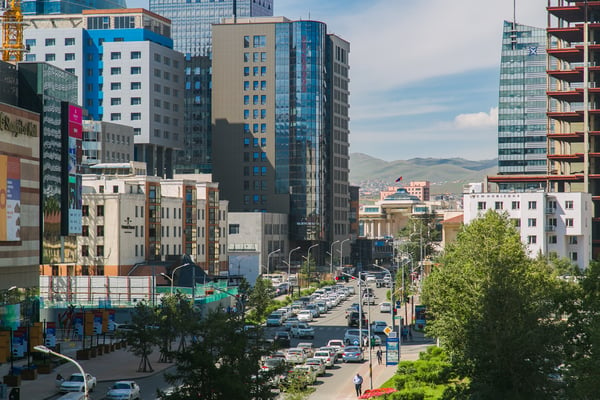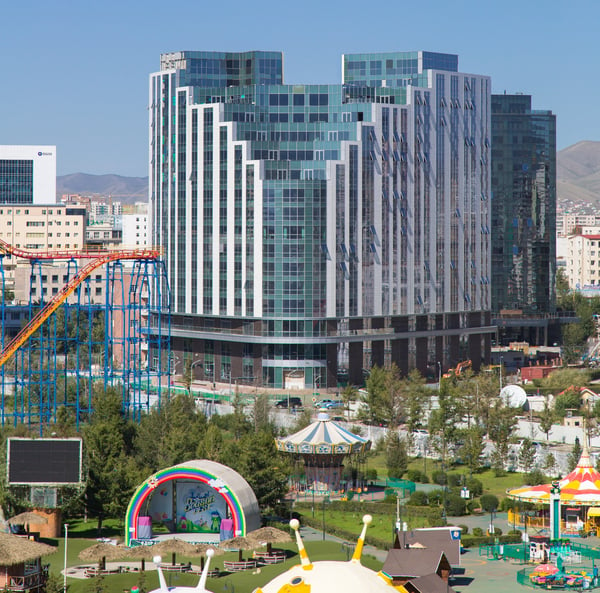Proximity to parks and green spaces has long been associated with increased property prices. Such spaces are determined by economists to have “hedonic value”. An early example of appreciation of the value of land surrounding green space is Regents’ Park. Constructed in London in the early 1800s with residences both inside and surrounding it, the park’s planners aimed to raise funds for the royal family by selling the park-side homes for a premium.
The first empirical study into the relationship between parks and house prices was conducted by Frederick Law Olmsted between 1856 and 1873. Olmsted identified the positive effect on house prices surrounding Central Park following its construction. However, the study attributed all increases in value to the park without considering the potential influence of other factors (e.g. increased population).
 CBD Ulaanbaatar, Mongolia
CBD Ulaanbaatar, Mongolia
Since then, more than thirty empirical studies have been conducted, with many adopting hedonic price modelling to provide a more nuanced picture of the value of different types of parks and their features. These studies— largely focused on North America and Europe—have found in general that ‘excellent’ parks tend to add 15% to the value of proximate homes, whilst parks that fall below par may detract 5% from the overall value.
Research has been conducted recently to investigate the same phenomenon in Seoul and Beijing. A 2012 Chinese study found that homes proximate to Beijing city parks attracted a premium on average of 10.9%. Parks in the city centre (within the second ring-road) were found to be particularly prized and can increase property values by up to 14.1%. These results corroborate the argument that parks in more densely populated areas close to the CBD have a greater positive effect on property prices.
.png?width=411&name=Screenshot_2018-08-30%2020120307%20pdf(1).png) Average housing prices in Beijing from 1991 to 2009 (Source: Journal of Resources)
Average housing prices in Beijing from 1991 to 2009 (Source: Journal of Resources)
Further studies have suggested that as a park matures and becomes a more established destination, its hedonic value increases. One example of this is the appreciation of value in houses surrounding the Hudson River Park. For residential sales in the Hudson River Development between 1997 and 2005, approximately 10% of the value of the property sold was attributable to the park. However, for homes sold between 2002 and 2005 five, the attributable percentage was found to have increased to 26%. This is due to the fact that the first section of the park at Greenwich Village was completed in 2003, and by 2005 the park had become a fully established destination.
Accessibility /distance from the park, and the quality of the park are the two main factors researchers have identified that affect hedonic value (both positively and negatively). If a property satisfies these two main criteria, its value should be positively affected. Whilst property values are often higher than average within 2000ft of the park, the greatest increase is seen within the first 500ft from the park gates. For small parks the first 500ft captures all of the premium, and for large parks it captures 75%.

National Amusement Park in Mongolia
An important aspect to consider when determining a park’s quality is its utility. Provided the facility is not over-used, property proximate to parks suitable for exercise, dog-walking, and equipped with children’s play areas may command a premium. Whether the park provides pleasure for its users is equally important. Natural areas containing woods, hills, ponds or marsh have a particularly strong positive effect on property values. Certain features of parks attract particularly high premiums. For example, studies have noted that properties with views of lakes enjoy 18% to 56% premiums, with one study identifying a “115% premium associated with a view of a creek or marsh”.
Property values may also increase due to the perceived health benefits for residents. Air quality is becoming an ever-increasing concern for city-dwellers, increasing the attractiveness of living in close-proximity to green areas. Trees and vegetation found in parks can help reduce air pollution by lowering air temperature and directly removing pollutants. This would seem to be of particular importance to Ulaanbaatar, a city severely affected by air pollution, and suggests that the city’s residents would be especially attracted to the potential associated health benefits of living near parks.
Proximity to green spaces may at times be detrimental to home values if the green space fails to adequately satisfy the ‘accessibility’ and ‘quality’ criteria. Parks have been shown to reduce the value of a home by up to 5%. However, in most cases even if the park does not possess all the ideal qualities, proximate properties will still show modest “increases in value compared to properties outside a park’s service zone”.
Olympic Residence in CBD, Ulaanbaatar
Parks that are poorly maintained, may be seen as a safety liability for nearby residents and therefore reduce house prices. A lack of maintenance can also affect the character of an area— e.g. if there is vandalism, excessive litter etc., thereby reducing house prices. Fox illustrated the importance of this by drawing on the analogy of an overgrown lawn and the detrimental effect it would have on the scaleability of the property. A report by Hometrack, a UK property database found that properties next to ‘derelict’ land say their value reduced on average by over £20,000 (15%). Certain types of park are valued over others—wide open space primarily used for athletic pursuits, for example, adds less value to a property than a passive park as the excessive noise generated is viewed as a nuisance factor.
Accessibility is equally important. Property value may be negatively impacted if the park does not have a sufficient number of entrances. Another key issue is if an arterial road separates the property and the park entrance. The noise and air pollution associated with traffic congestion from the road may also negatively impact increases in house values. For example, the value increases for properties located one block further away from Hudson River Park were observed to be much higher that for those directly facing the park (2002-5 19.7% vs 10.3%).
Historical evidence suggests that as cities develop, there is increased competition for land surrounding parks. For example, following the success of Central Park, calls were generated for further public parks to be constructed towards the periphery of the city to encourage residential development. There were similar calls for development of parks in cities across America at the time. The proponents justified the investment by arguing the houses around the park would attract a premium, and therefore higher property tax, which would offset the cost of park construction. This is the so-called ‘proximate principle’. A more recent example is the Hudson River Development.
 A busy street of Ulaanbaatar
A busy street of Ulaanbaatar
Following the announcement in 1998 that the first section of the Hudson River Park at Greenwich Village was to be constructed, the number of construction projects on the land surrounding the park increased dramatically. By 2002, sold prices for the apartments in the three new residential developments were some of the highest in Manhattan—indicative of the developers’ recognition of the premium park-side homes would attract.
As a city develops economically, its population becomes increasingly mobile and willing to pay to live near the amenities they appreciate. The American Planning Association has noted that increasingly wealthy US retirees in particular are seeking homes that provide easy access to leisure activities and a sense of community—such as those proximate to parks. The same paper noted that proximity to open space attracts so-called ‘knowledge workers’ (workers who sell their knowledge as opposed to physical labour). It may be argued that as a city develops and becomes wealthier, the ‘desirable’ residents that parks attract have a subsequent positive effect on the area as a whole and raise house prices. This suggests that as a city’s economy improves—land proximate to parks and green spaces is likely to appreciate in value.
There is evidence to suggest that as countries and cities develop, their populations become increasingly concerned with sustainability. As cities become more densely populated, many city-dwellers begin to crave open spaces with clean air, and visits to parks consequently increase. For example, between 2007 and 2012 visits to South Korea’s mountain-based national parks rose from 21 million to 41 million annually. PWC has noted that as the world urbanises, the pressures to make buildings more eco-efficient are mounting and integrating green spaces into developments has become global trend in developed cities. The company estimates that by 2020 all buildings in advanced economies will need to have sustainability ratings. Therefore, developments near parks in Ulaanbaatar may become more popular in the coming years in order to adhere to international best practice (PWC).
Olympic Residence in CBD, Ulaanbaatar next to National Amusement Park
It is reasonable to assume that Ulaanbaatar will follow the trends witnessed in other cities as it develops. The hedonic value of the National Amusement will be high, and increase over time. This is principally due to the park’s location in the premier Sukhbaatar District, close to the CBD. Additionally, the park is easily accessible and well-maintained (having undergone a six-year renovation programme finishing in 2011). Land surrounding the National Park on the road to Zaisan should also command a premium. As noted previously, hedonic value tends to be higher for parks that provide natural settings for relaxation, such as ponds, trees, hills and open spaces. Further, the study relating to property in Beijing is particularly encouraging for Ulaanbaatar as both cities are facing particularly acute problems with air quality.




